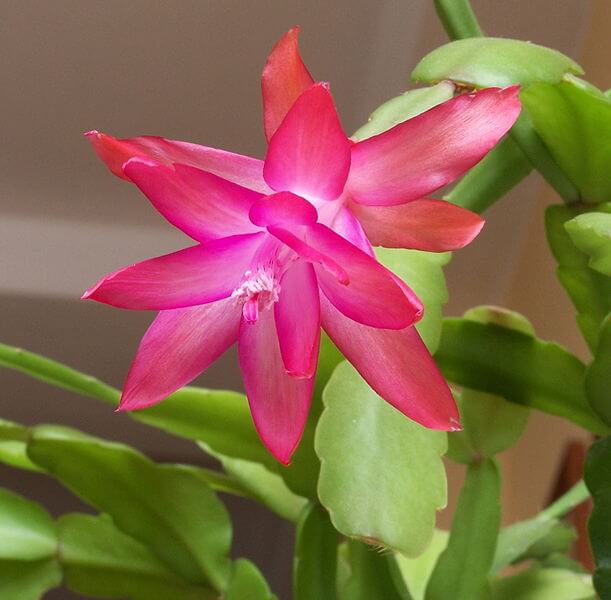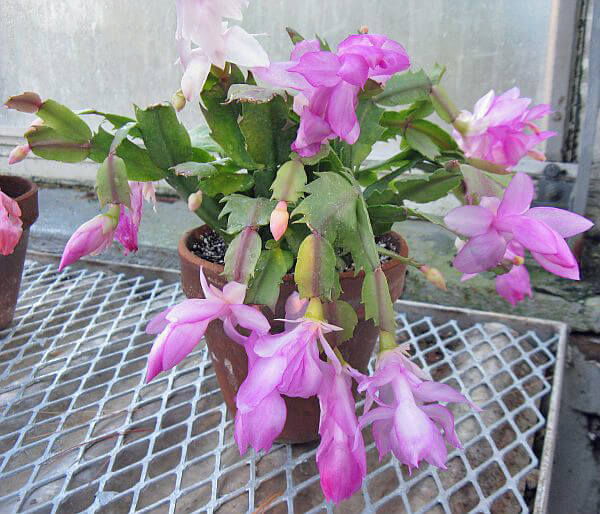
Although bought and sold by the millions during the Thanksgiving season, “Christmas cactus” remain something of an enigma. For example, why do plants that bloom at Thanksgiving bear the name “Christmas”? why do they reputedly mope as houseplants, when they bloom so lavishly in your local supermarket?
Their form itself is puzzling. The showy blooms arise directly from what appear to be arching chains of fleshy leaves, which in fact are flattened, narrow-jointed stems. The shape and spininess of these leaf-like stem segments are key to identifying Christmas cactus and its relatives, which all belong to the genus Schlumbergera.
Christmas Cactus Types

Crab (aka Thanksgiving) cactus, Schlumbergera truncata is the most common type grown and blooms around Thanksgiving.
Examine the stem segments of the Schlumbergera that throng the stores as Thanksgiving approaches, and you’ll discover the answer to the riddle of their name: they aren’t Christmas cacti at all. Almost all plants sold under the Christmas moniker exhibit the jagged-toothed stem segments characteristic of crab (aka Thanksgiving) cactus, Schlumbergera truncata. In contrast, true Christmas cacti possess bluntly toothed segments that bear pendent (rather than horizontal) blooms in early winter. If you want a yuletide Schlumbergera, look for varieties of the real McCoy, Schlumbergera x buckleyi (the hybrid between Schlumbergera truncata and Schlumbergera russelliana). If you want a Thanksgiving cactus – go to your local garden center or upscale grocer right about now.

Whichever Schlumbergera you bring home from the store, one thing’s for certain: it ultimately comes from moist, humid, relatively cool upland forests of Southeast Brazil, home to all six species in the genus. In their native haunts, these succulent evergreens grow as epiphytes and lithophytes, taking root in decayed leaves and other detritus that accumulate on moss-covered tree limbs and rock ledges.
Cultivating Christmas Cactus
They are easily cultivated (and flowered) in conditions that mimic their natural circumstances: bright full shade; well-drained, humus-rich, evenly moist growing medium; moderate to high humidity; and moderate temperatures. A hanging basket filled with Fafard Ultra Container Mix will suit them nicely, as will a northeast- or northwest-facing windowsill, or a lightly shaded southern exposure. Water them thoroughly when the top inch or so of the growing medium is dry, applying a complete liquid fertilizer every few waterings. Many Schlumbergera aficionados keep their plants outdoors (either suspended on hooks or elevated on stands) during the frost-free season. A spot under a shade tree will provide ideal spring to fall growing conditions in most parts of the United States.

Lighting
Contrary to popular horticultural myth, neither Christmas nor Thanksgiving cactus requires any mystical lighting, watering, or temperature regimens to induce them to bloom. Although lengthening nights do indeed trigger flower bud development, natural light cycles at United States latitudes (where winter nights are considerably longer than those in the plant’s native Southeast Brazil) provide ample darkness. Placing the plants in a dark closet for 14 hours a day (as is often and erroneously prescribed) may slightly hasten bud development, but is not required (and may do more harm than good).
Temperature
Temperatures below 60 degrees F will also encourage bud formation, but “more cold” will not result in more flowering (and white- and yellow-bloomed varieties will become pink-tinged if brought from bud to flower at sub-70-degree temperatures). In most parts of the United States, ambient outdoor temperatures and natural illumination (with no strong artificial night lighting) will do quite nicely. So rather than exiling your cactus to a closet, move it to a shaded porch for a late-summer to early-fall vacation. Plants may even rebloom in late winter if they continue to receive long nights and proper care.
Christmas Cactus Varieties

Schlumbergera truncata ‘Wellesley’ is a pretty pale pinkish-purple variety.
Schlumbergera fanciers have it good these days: the numbers of Thanksgiving and Christmas cactus varieties rival those available in the nineteenth century, when Schlumbergera were widely grown and highly popular. Many cultivars (often un- or mis-identified) of Schlumbergera truncata and its hybrids are grown and sold, including new developments such as the Reginae Group, a series of crosses between Thanksgiving cactus and the relatively early-blooming Schlumbergera orssichiana.
Real Schlumbergera maniacs might want to give some of the more obscure and difficult species a try, including the aptly named prickly-pear schlumbergera, Schlumbergera opuntioides, and its hybrids. Christmas comes many times a year if you’re a Schlumbergera enthusiast.

